
Camassia quamash, commonly known as camas, small camas, common camas, common camash or quamash, is a perennial herb. It is native to western North America in large areas of southern Canada and the northwestern United States.

Drosera capillaris, also known as the pink sundew, is a species of carnivorous plant belonging to the family Droseraceae. It is native to the southern United States, the Greater Antilles, western and southern Mexico, Central America, and northern South America. It is listed as vulnerable in the US state of Virginia, and critically imperiled in Arkansas, Maryland, and Tennessee.

Aronia arbutifolia, called the red chokeberry, is a North American species of shrubs in the rose family. It is native to eastern Canada and to the eastern and central United States, from eastern Texas to Nova Scotia inland to Ontario, Ohio, Kentucky, and Oklahoma.
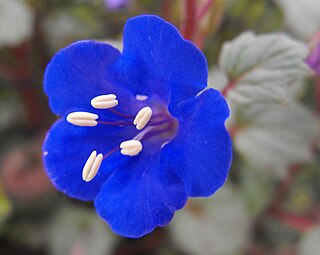
Phacelia campanularia is a species of flowering plant in the borage family, Boraginaceae, known by the common names desertbells, desert bluebells, California-bluebell, desert scorpionweed, and desert Canterbury bells. Its true native range is within the borders of California, in the Mojave and Sonoran Deserts, but it is commonly cultivated as an ornamental plant and it can be found growing elsewhere as an introduced species.

Dicentra canadensis, the squirrel corn, is a flowering plant from eastern North America with oddly shaped white flowers and finely divided leaves.
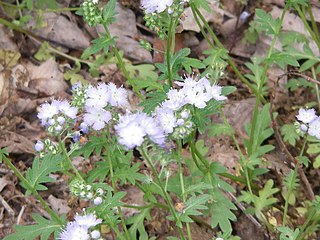
Phacelia purshii, known by the common names Miami mist, scorpionweed, and purple scorpionweed, is a spring flowering annual forb with blue, lavender, violet, or nearly white flowers in the Boraginaceae (borage) family that is native to eastern and central North America.
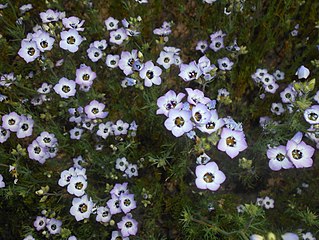
Gilia tricolor is an annual flowering plant in the phlox family (Polemoniaceae).

Coreopsis grandiflora is a North American species of perennial plant in the family Asteraceae. The common name is large-flowered tickseed. It is found in eastern Canada and much of the United States, especially the south-central part of the country. The species is widely cultivated in China and naturalized there.

Monardella villosa is a plant in the mint family which is known by the common name coyote mint. In 2020, it was included in Monardella odoratissima. As of April 2024, acceptance of the inclusion varies.
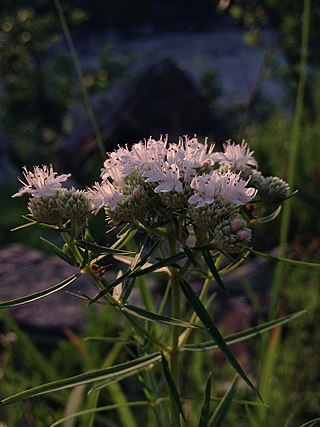
Pycnanthemum tenuifolium, the narrowleaf mountainmint, slender mountainmint, common horsemint or Virginia thyme, is a perennial herbaceous plant in the mint family, Lamiaceae. It is native to central and eastern North America.
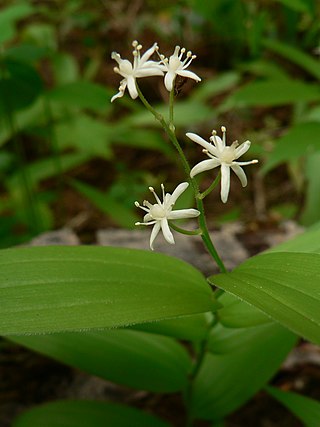
Maianthemum stellatum is a species of flowering plant, native across North America. It has been found in northern Mexico, every Canadian province and territory except Nunavut, and every US state except Hawaii and the states of the Southeast. It has little white buds in the spring, followed by delicate starry flowers, then green-and-black striped berries, and finally deep red berries in the fall.

Sambucus racemosa is a species of elderberry known by the common names red elderberry and red-berried elder.
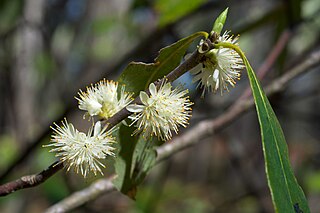
Symplocos tinctoria is a deciduous or evergreen shrub or tree. It is recognized by pith of twigs chambered; by foliage not notably aromatic when bruised, leaves finely hairy beneath. Shrubs or trees to 17 m tall by 36 cm diameter at breast height. The largest first-year twigs are under 3 mm across, terminal buds with acute tip, scales ciliate. Leaves are 7–15 cm long, margin entire or occasionally some teeth on the apical half, with a sweet taste that may be faint in old leaves. It is conspicuous when in flower; flowers opening before new leaves develop, fragrant, in clusters from axils of previous year's leaves or from just above the leaf scars if the leaves have fallen; the petals are creamy yellow to yellow, with one pistil. Fruits nearly cylindrical to ellipsoid drupes 8–12 mm long, with thin pulp and a hard stone containing one seed; the tip usually retaining parts of the sepals. Foliage is relished by browsing wildlife. A yellow dye may be obtained from bark and leaves. It flowers March to May.

Convolvulus tricolor is a species of flowering plant in the family Convolvulaceae, native to Mediterranean Europe. Common names include dwarf morning-glory, tricolour convolvulus, and belle de jour.

Sidalcea malviflora is a species of flowering plant in the mallow family, known by the common names dwarf checkerbloom, Greek mallow, prairie mallow and dwarf checkermallow.

Sidalcea oregana is a species of flowering plant in the mallow family known by the common name Oregon checkerbloom.
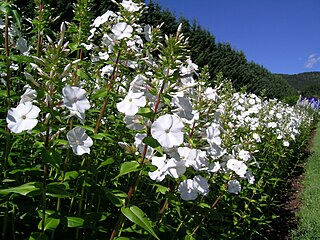
Phlox carolina, the thickleaf phlox, is a species of flowering plant in the family Polemoniaceae. It is an herbaceous perennial growing to 1.2 m (4 ft) tall by 45 cm (18 in) wide, with leaves to 13 cm (5 in) long, and purple or pink flowers in summer. The specific epithet carolina refers to its native habitat in the eastern United States. It grows in woodland edges and openings. Flowers attract bees, hummingbirds, and butterflies.

Clethra acuminata, the mountain pepper bush, is a shrub native to the Appalachian Mountains of the southeastern United States. It has been reported from the states of Pennsylvania, West Virginia, Virginia, North Carolina, South Carolina, Georgia, Alabama and Tennessee, primarily from deciduous forests at elevations of 500–1,400 m (1,600–4,600 ft).

Phlox glaberrima, commonly called smooth phlox and sometimes marsh phlox, is a species of flowering plant in the phlox family. It is native to the Midwestern and Southeastern United States where it is found in moist to wet areas. It can be found in both prairies and forests, where it is an indicator of high quality habitat.
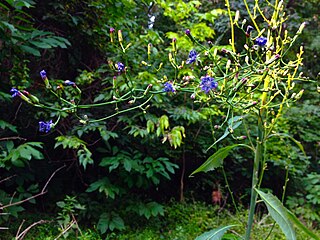
Lactuca floridana, commonly known as woodland lettuce, Florida lettuce, or false lettuce is a North American species of wild lettuce. It is native across much of central Canada and the eastern and central United States.




















